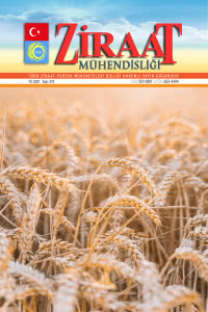GELENEKSEL BİR ÜRÜN OLARAK “MİDYE DOLMA” VE GELECEK ÖNERİLERİ
Su ürünleri besleyici özellikleri ile öne çıkan bir gıda maddesidir. Bu kaynağa erişimin arttırılması için üretimin artmasının yanında tüketiciye ulaştırılma biçimlerinin de geliştirilmesi ve gıda güvenliği prosedürlerine uygun hale getirilmesi beklenmektedir. Bir kabuklu su ürünü olan midye, çeşitli şekillerde işlenerek değerlendirilmektedir. Pek çok ülkede oldukça popüler olan midye, finansal açıdan yüksek getirisi olan bir kaynaktır. Midye dolma Türkiye’de sokak yemeği kültürünün önemli bir parçasıdır. Ancak yapılan çalışmalara göre sokakta satılan midye dolmaların bir kısmı mikrobiyal yük açısından kabul edilebilirlik sınırların üzerindedir. Bunun en önemli nedenleri, kontrolsüz toplayıcılık ve üretimdir. Tüm bu olumsuzlukların giderilmesi için, kontrollü şartlarda yetiştiricilik ve üretimin yapılması elzemdir. Bu çalışma; midye dolma açısından midye etine erişim ve işleme prosesleri hakkında mevcut problemler ve gelecek önerilerini kapsamaktadır.
Anahtar Kelimeler:
Midye, Midye dolma, Kontrollü midye yetiştiriciliği, Midye işleme
As a traditional food “stuffed mussel” (Midye Dolma) and its future aspect
Aquatic products are foodstuff that stands out with its nutritive properties. In order to increase access to this resource, it is expected that the ways of delivering to consumers as well as increasing production will be improved and adapted to food safety procedures. Mussels, which are a shellfish, are processed in many ways. Mussels, which are very popular in many countries, are a source of high financial gain. Stuffed mussels are an important part of the street food culture in Turkey. However, according to the studies, a portion of stuffed mussel sold on the street is above the acceptable limits in terms of microbial load. The most important reasons for this are uncontrolled gathering and production. In order to eliminate all these problems, aquaculture and production under controlled conditions is essential. This study covers current problems and future suggestions about access and processing of mussel meat in terms of stuffed mussels.
Keywords:
Mussel, Stuffed mussel, Mussel aquaculture, Mussel processing,
___
- 1- Parmalee, P.W. ve Klipper, W.E., 1974. Freshwater mussels as a prehistoric food resource. American antiquity, 39:3, 421-434.
- 2- Terzi, G. Gücükoğlu, A. Çadırcı, Ö. Uyanık, T. ve Alişarlı, M. 2015. Serotyping and antibiotic susceptibility of Listeria monocytogenes isolated from ready-to-eat foods in Samsun, Turkey. Turkish Journal of Veterinary and Animal Sciences, 39:211-217.
- 3- Bingöl, E.B. Çolak, H. Hampikyan, H. ve Muratoğlu, K. 2008. The microbiological quality of stuffed mussels (Midye Dolma) sold in Istanbul. British Food Journal, 110(11): 1079 – 1087.
- 4- Özel İhtisas Komisyonu Raporu 2014. Su Ürünleri. ISBN 978-605-4667-67-3 YAYIN NO: KB: 2871 - ÖİK: 721.
- 5- TÜİK 2015. Su ürünleri istatistikleri. T.C. Gıda Tarım ve Hayvancılık Bakanlığı, Balıkçılık ve Su Ürünleri Genel Müdürlüğü, Mart 2015.
- 6- TÜİK 2018. Su ürünleri istatistikleri. T.C. Gıda Tarım ve Hayvancılık Bakanlığı, Balıkçılık ve Su Ürünleri Genel Müdürlüğü, Ağustos 2018.
- 7- Görkem, O. 2015. Franchising Sistemi Uygulanan Fast Food İşletmelerinde Örgütsel Bağlılık: Denizli Örneği. Journal of Business Research Turk, 7(1):267-279.
- 8- Güler, S. 2010. Türk Mutfak Kültürü ve Yeme İçme Alışkanlıkları. Dumlupınar Üniversitesi Sosyal Bilimler Dergisi, 26: 24-30.
- 9- Acar Tek, N. ve Sürücüoğlu, MS. 2014. Basılmış olan ilk Türk yemek kitabı “Melceü’t-Tabbahin”. Gazi Türkiyat, 14:225-229.
- 10- Castellani, V. 2004. Les cuisines de rue. ISBN: 9782742749324
- 11- Şireli, UT ve Gücükoğlu, A. 2008. Prevalence and Antibiotic Resistance of Listeria Spp. Isolated from Ready-to-Eat Foods in Ankara. Turkish Journal of Veterinary and Animal Sciences, 32(2): 131-135.
- 12- Göksoy, E.Ö. Kırkan, Ş. ve Kaya, O. 2006. Comparison of Polymerase Chain Reaction and Conventional Methods for the Diagnosis of Listeria monocytogenes in Stuffed Mussels. Turkish Journal of Veterinary and Animal Sciences, 30:229-234.
- 13- Terzı G, Gucukoglu A, Cadırcı O, Kevenk TO ve Alısarlı M. 2013. Effects of Chitosan and Lactic Acid Immersion on the Mussels" Quality Changes During the Refrigerated Storage. ournal of the Faculty of Veterinary Medicine, Kafkas University, 19 (2): 311-317, 2013. DOI: 10.9775/kvfd.2012.7779.
- 14- Doğan Halkman, HB ve Halkman, AK. 2004. Gıdalarda Escherichia coli Olmayan Fekal Koliformlar Üzerine bir Araştırma. Orlab On-Line Mikrobiyoloji Dergisi, 2(2):1-5.
- 15- Ateş, M. Özkızılcık, A. ve Tabakoğlu, C. 2011. Microbiological Analysis of Stuffed Mussels Sold in the Streets. Indian Journal of Microbiology, 51(3):350-354.
- 16- Ulusoy, Ş. ve Özden, Ö. 2011. Preservation of Stuffed Mussels at 4°C in Modified Atmosphere Packaging. Journal of Aquatic Food Product Technology, 20:3, 319-330.
- 17- Monford, 2000. The French Market for Mussels: Dominant Features, Competitive Forces and Prospects. SNF-REPORT NO. 05/2000. Centre for Fisheries Economics Report No. 62. Foundation for Research in Economics and Business Administration, Bergen, Fransa.
- 18- Alçiçek Z., Balaban M.O., 2015a. Characterization Of Green Shelled Mussel Meat. Part I: Quantification Of Color Changes During Brining And Liquid Smoke Application Using Image Analysis. JOURNAL OF AQUATIC FOOD PRODUCT TECHNOLOGY, vol.24, pp.2-14.
- 19- Alçiçek Z., Balaban M.O., 2015b. Characterization Of Green Lipped Mussel Meat. Part II: Changes In Physical Characteristics As A Result Of Brining And Liquid Smoke Application. JOURNAL OF AQUATIC FOOD PRODUCT TECHNOLOGY, vol.24, pp.15-30.
- 20- Huss, H.H. 1995. Quality and quality changes in fresh fish. FAO Fisheries technical paper . No. 348, 195p pp. Roma: FAO.
- ISSN: 1301-0891
- Yayın Aralığı: Yılda 3 Sayı
- Başlangıç: 1966
- Yayıncı: Mehmet Ali ÜNAL
Sayıdaki Diğer Makaleler
BİR BALIKÇI BARINAĞI ÇALIŞMA ALANI RİSK FAKTÖRLERİ: İZMİR İLİ ÖRNEĞİ
GELENEKSEL BİR ÜRÜN OLARAK “MİDYE DOLMA” VE GELECEK ÖNERİLERİ
HİDROJEN PEROKSİT (H2O2)’İN SU ÜRÜNLERİNDE KULLANIMI
Hasan Hüseyin ATAR, Saliha AKBAŞ, ZAYDE AYVAZ
8x8 EKMEKLİK BUĞDAY DİALLEL MELEZ F3 POPÜLASYONUNDA HETEROSİS VE HETEROBELTİOSİSİN SAPTANMASI
ZİYA DUMLUPINAR, Hüseyin GÜNGÖR, Tevrican DOKUYUCU, ERTUĞRUL FİLİZ, Harun OCAKTAN, Ayşenur UYSAL, Gökhan ERDİNÇOĞLU, AYDIN AKKAYA
